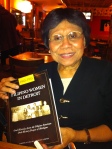YEA team visits Hush House Museum for panel discussion on gentrification in Zone 8
April 6, 2012
ZONE 8, Detroit – Members of EMEAC's Young Educators Alliance (YEA) visited the Hush House Black World Museum and Leadership Training Institute for Human Rights on April 3 for an informal intergenerational panel discussion on gentrification with Hush House Co-Founder Dr. Charles Simmons and Zone 8 Neighborhood Community Activist and author Yusef Bunchy Shakur. Representing the YEA team were Noelle Frye, Rayven Roberts and Ingrid Barnes along with EMEAC Associate Director Ahmina Maxey and Stand Up! Speak Out! Youth Coordinator William Copeland.
“With the Young Educators Alliance we talk a lot about developing leadership and how we can develop young activists. We'd like for them to gain those skill sets, and Hush House is a very important community resource,” Copeland said. “It's good just to see the continuity of the generations and the trains of thought can be seen in their minds. There is a lot of experience with Baba Charles and Yusef sharing their experiences in the neighborhood. With YEA, they are just beginning to make that path of making a difference. It's good to see the connections made and hear the thoughts percolate.”
The conversation began with Dr. Simmons, who's background includes working for the Muhammad Speaks Newspaper founded by Civil Rights icon Malcom X, several years as a professional journalist – including a stint with the United Nations, and professorships at Howard and Eastern Michigan Universities, giving a historical overview of gentrification as it relates to the city of Detroit and the neighborhood known as Zone 8 today. Shakur, who has chronicled his life's struggle as a former gang member who later met his father in prison before going on to turn his life around after prison in his two books: The Window to My Soul and My Soul Looks Back: Restoring the Neighbor Back to the 'Hood, next spoke about the modern history of Zone 8 and his efforts to rebuild his community as a young entrepreneur and activist.
“It was very knowledge filling and I got some points on my gentrification project that I can use to make a successful presentation,” said Frye who along with Barnes is studying Environmental Sciences at Wayne State University. “It definitely showed me that history has just about repeated itself. It shows me that the daily struggles that they went through have come back. It's not like flat out racism in your face but it's like secretive racism behind the scenes that you can only see sometimes through history.”
Barnes, who recently joined the YEA team said the event was just the kind of experience she was hoping to get out of the program.
“I just joined the group but I'm glad I came today because I found out more information about our history and (gentrification),” she said. “I definitely want to learn from more people about the environment and get them to stand up for making this a better community.”
After the panel presentations and a brief question and answer session, Dr. Simmons took the team on a tour of the museum which features a collection of historical images, articles, paraphernalia and even consumer products depicting the portrayals of African-Americans in Detroit and around the world. The Museum, which was converted from the neighborhood home of Simmons' grandmother is under the directorship of Simmons' wife Dr. Sandra Simmons who currently teaches at Wayne State University.
“I think these types of intergenerations meetings with the young people of Detroit and some of the elders at places like the Hush House really reflect the role of young people in changing societies, changing conditions and changing the world,” he said. “In most of these struggles globally where we have fundamental changes taking place, it's young people in the leadership.
“Whether it was the Arab Spring, the Civil Rights Movement, the Labor Movement, the Abolitionist Movement, it's always been young people who are generally in the vanguard of changing the world to make it better. When you mention African-American history or Black history, you should keep in mind that that is American history and it's world history. The information that we are getting about U.S. History is totally distorted. The perspective of the history that's taught is from the top down. It's what the great kings and queens and presidents and senators did, but what did the common people do? What did the serfs do? What did the workers do?”
After the tour, Roberts said she feels more empowered to share the things she's learning with other young people. She also hopes it can help this generation make better sense of what is going on around them.
“Out of this I got that I should really go share more stories with the young people my age and the generation under me about the things that happened back before I was even thought of,” she said. “These things are contributing to the problems that we have going on now.”












